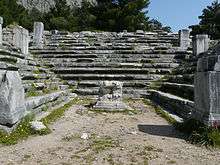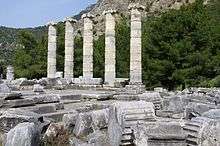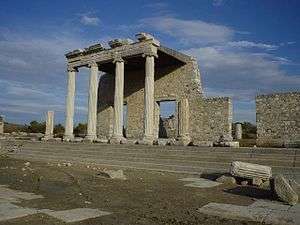Priene, Miletus, and Didyma
Priene, Miletus, and Didyma are three ancient Greek ruins near each other in western Turkey. They are often visited on a combined "PMD" tour from Selçuk.
Understand
🌍 Priene, at the base of an escarpment of Mycale (modern Mt. Samsun inside the Dilek Peninsula National Park), used to be a major coastal city. Its harbour has since been silted up by the Meander River. It was the earliest town built on a grid plan. Priene was a member of the Ionian League, and is believed to have had 4,000-5,000 inhabitants at its peak.
🌍 Miletus (Turkish: Milet), the greatest and the wealthiest of the Greek cities before the Persian invasion of the 6th century BC, was another major harbour city, its sailors having founded a huge number of colonies, especially around the Black Sea.
🌍 Didyma was the sanctuary of Miletus, from where visitors approached by following a sacred path of 17 km on foot. Modern Didim, formerly a village named Yenihisar surrounding the ancient site, has been developed as a resort town in the 1980s. It is now centred around the Altınkum ("golden sand") beach south of the original village and has a vibrant British expat community.
Get in
By bus tour
The easiest option is to join a bus tour from one of the travel agencies in Selçuk during the summer.
In the off-season, ask your hotel in Selçuk to arrange a private driver for 350 TL or a travel agency who will charge 450 TL (Nov 2017). The trip will take about 6½ hours, which provides ample time at each site, including the Miletus Museum. Extra time would be needed if you stop for lunch.
By minibus
Priene is near the modern village of Güllübahçe, take a minibus (dolmuş) from Söke to get there.
Miletus is near the modern village of Balat, 3 km north of Akköy — take a minibus from Didim to Akköy, and walk the rest or wait for the infrequent dolmuşes on to Balat.
Didyma is just north of the modern resort town of Didim and is easily walkable from there.
By car
It is easy to drive between the sites via the secondary road numbered 09-55 and its southern extension 09-54. The major regional highway, D525, has a number of connections with 09-55/-54 along its alignment between Söke and Milas, all clearly signposted for either Priene, Miletus, or Didyma.
Fees and permits
Each site has a seperate entry fee: 5 TL for Priene, and 10 TL each for Miletus (plus an extra 5 TL for the museum on site) and Didyma.
The Museum Pass – The Aegean (75 TL, valid for 7 days) provides free entry to all three sites (as well as many others in the Aegean Region and some in Lycia), although it cannot be bought locally in any of them (better ask for it while in Ephesus).
Get around
No single town has connections to all of these sites, so you need to travel back and forth between Söke (minibuses to Güllübahçe/Priene) and Didim (walking distance to Didyma and minibuses to Balat/Miletus) if you have to use the public transport.
Within the sites themselves, walking around is likely your only option.
See
Priene
Its evocative hillside ruins, surrounded and partially covered by a dense pine forest, include a Temple of Athena, a small Hellenistic theatre, and parts of the city walls. Little has been reconstructed, so bring your imagination.


The Temple of Athena, funded by Alexander the Great, at the foot of an escarpment of Mycale. The five columns were erected in 1965–66 from rubble and are 3 metres (9.8 ft) short of the calculated original column height.
While you are there, you may also want to check out 🌍 Old Güllübahçe (Gelebeç), a pleasant hillside village of cobbled streets and stone houses (close to Priene but requires some uphill walking). The village was inhabited by the Greeks before the Greco–Turkish War of 1919–22, and an abandoned church dedicated to St. Nicholas, dating back to 1821, exists, along with its ossuary.
Miletus


A well-preserved amphitheatre, an Ionic stoa along one of its main roads, and a Roman bathhouse are among the ruins to see in Miletus.
A medieval mosque built by the local Turkish kingdom of Menteşe in 1403, when the city was still inhabited, is also worth visiting at the site. Parts of the site get seasonally inundated, providing a more atmospheric feel.
Didyma
There was an oracle here that was as famous as Delphi in the Hellenic world, and a colossal Temple of Apollo with much ancient Greek art, including the Medusa head which is one of the most recognized sights of the region, with its picture usually making it into the tourism brochures.
Buy and eat
Priene has no shop (or WC facilities).
At Miletus, there is a caravanserai to your right when facing the theatre. It has some stalls sell souvenirs, a WC, and a café selling food. The museum also had a small shop.
There are restaurants and souvenir shops at the entrance to the temple at Didyma.
Sleep
While Didim/Didyma has a large selection of hotels and guesthouses to choose from, the other two sites do not have any. Selçuk is probably your best bet to overnight and use as a base for a visit to Priene, which is relatively far and hard to get to by public transport from Didim. You can also try your luck in Söke, a major agricultural town that is nearer.
Go next
- Doğanbey — 15 km west from Priene/Güllübahçe, Doğanbey sits on the southern slopes of the Mt. Samsun and is another former Greek village in the area. In the 1990s, some ecologically-minded urban dwellers from elsewhere "discovered" the place, buying its hitherto already well preserved stone houses, renovating them, and moving in. It is now one of the finest villages in the country.
- Ephesus — the much-better known cousin of the trio to the north is among the best preserved Greco-Roman ruins in all the Mediterranean basin.
- Milas — historically known as Mylasa, Milas is a major regional town to the southeast rich in ancient and medieval sites.
- Bodrum — Turkey's partying capital is further down the coast to the south.